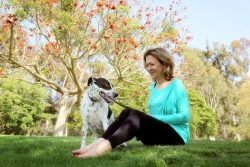On the outskirts of Culver City is Kenneth Hahn State Recreation Area, managed by the Los Angeles County Department of Parks and Recreation. This park is an oasis in the middle of the city.
It includes large areas of native coastal sage scrub habitat, lawns and landscaped areas, picnic sites, tot lots, fishing lake, lotus pond, community center and five miles of trails. There are six restrooms; the community center has four administrative offices and a small meeting room.
One of the most actively used features is the park’s variety of footpaths and trails. The Burke Roche Trail and the Rim Trail are the most recent trails created.
Trails from the parking lot climb up one of the few hills in the middle of the Los Angeles basin.
“I love this place. It’s a great escape from the city. There is a beautiful view of the entire Los Angeles City on a smog free day. The view ranges from the ocean, the Hollywood sign, to the buildings in LA downtown, and further east,” said Pierre Gustavo.
From the top, you can see the defining elements of L.A.’s landscape: the curved bay in the west, the Hollywood Hills to the north, and the towering snow-capped mountains to the east.
“This is a fantastic trail filled with lake, city, and garden views. This is perfect for beginner hikers and ones who love Japanese Gardens,” said Rachel Baskett.
At the bottom of the hill, Hahn Park has family zones. There are picnic and barbeque areas, soccer and baseball fields and basketball courts. People can feed ducks and fish in the landscaped streams, waterfalls, and lakes.
“It is a family oriented park with many outdoor activities available. It’s also a park where one could go and relax or get some good old fashion exercise,” said Joseph Herr.
Nearby neighborhood parks found along the main thoroughfares surrounding the Kenneth Hahn State Recreation area include Jim Gilliam Park, Norman O. Houston Park, Culver City Park and Ladera Park.
In 1932 the area east of the park was used as the site of the first Olympic Village ever built, for the 1932 Summer Olympics in the 10th Olympiad, which Los Angeles hosted.
Los Angeles later hosted the 1984 Summer Olympics, drawing athletes from 140 nations. To serve as a continual reminder of the events, 140 trees have been planted together on the hills where the 1932 Olympics took place, with each tree representing a nation that took part in the 1984 Olympics.
Between 1947 and 1951 the Baldwin Hills Reservoir was built in the hills on the future park site.
In 1963 the reservoir’s dam collapsed disastrously, washing away residences in the canyon and flooding the landmark Baldwin Hills Village at the hills’ foot.
The news coverage of the disaster was the first time aerial footage was televised live. The reservoir’s empty bowl is still visible.
For the first half of the 20th Century, the park was an active oil field. After an accident in 1968, most of the pumps were shut down and conservationists and neighbors turned the area into a park. There are still a number of active oil pumps on the adjacent hillside.
The Basics:
- Distance: 2.6 miles
- Elevation Gain: 243 feet
- Time: 90 Minutes
- Trail Condition: Excellent. While some trail junctions are not clearly marked and there are a few use-trails not included on the official park map, this is a very easy park to navigate.
- Directions: From the west, take the 10 and get off at the La Cienega Blvd. exit. From the east, take the exit for Washington Blvd. / Fairfax Ave. and continue on Washington for about a half mile before turning south onto La Cienega. Continue on La Cienega for 1.4 miles and take the exit for the Kenneth Hahn State Recreation Area. Car entrance to the park costs $6.
- Public Transit Directions: On weekends and holidays from 8 a.m. to 6 p.m., a shuttle travels every 20 minutes between the Expo Line La Cienega Station, Kenneth Hahn State Park, and the nearby Baldwin Hills Scenic Overlook. Fare is 25 cents.

